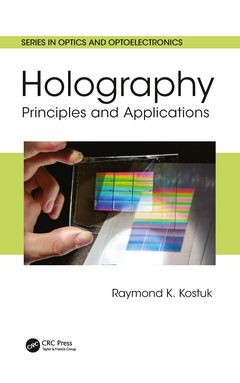Holography Principles and Applications Series in Optics and Optoelectronics Series
Auteur : Kostuk Raymond K.

Holography: Principles and Applications provides a comprehensive overview of the theory, practical considerations, and applications of holography. The author has spent his career working on different aspects of this subject, and in this book, conveys the foundation for others to use holography and holographic concepts in a variety of important applications. Special emphasis is placed on the analysis of the imaging and diffraction efficiency properties of holographic optical elements that are finding increasing use in medical imaging, solar conversion systems, and augmented reality eyewear. A comprehensive overview of holographic materials is also given as this area is critical for implementing successful holographic designs. The important areas of digital and computer generated holography are also presented to give the reader an understanding of these topics. The author has attempted to explain each subject in a manner that he has found effective in teaching holography for over thirty years.
This book is suitable for researchers and as a textbook for graduate students in optics, physics, and engineering. As an aid to instructors and students, the book includes exercise problems and a set of laboratory experiments to enhance understanding. Methods for preparing and handling holographic materials is also provided to help individuals develop experimental capability in holography. In addition, over 450 current and foundational references are provided to help the researcher probe further into this interesting and useful subject.
Features
- Offers a systematic, rigorous account of the principles, techniques, and applications of holography;
- Describes the process of design, implementation, and evaluation of a variety of holographic optical elements;
- Provides an extensive overview of holographic materials including preparation, handling, and processing techniques;
- Includes exercise problems and laboratory experiments.
Raymond K. Kostuk is a professor of Electrical and Computer Engineering in the College of Engineering and also has a joint professor appointment in the James C. Wyant College of Optical Sciences at the University of Arizona. He received a Bachelor of Science Degree from the United States Coast Guard Academy and served as an officer in the United States Coast Guard for 10 years. During that time, he was sent to the University of Rochester where he received a Master of Science Degree in Optical Engineering from the Institute of Optics. After completing his military service, he went to Stanford University and obtained his doctorate under the advisement of Professor Joseph W. Goodman working on applying multiplexed holograms to optical interconnect systems. After graduating, he spent a year at the IBM Almaden Research Center where he worked with Glenn Sincerbox on problems related to optical data storage. He then went to the University of Arizona and has continued to work on various types of optical systems with the main focus on holographic optical elements and holographic materials. He has published over 80 journal papers and several book chapters and patents primarily related to different aspects of holography. He is a fellow of the Optical Society of America and the Society of Photo Instrumentation Engineers
Date de parution : 03-2021
17.8x25.4 cm
Date de parution : 06-2019
17.8x25.4 cm
Thèmes de Holography :
Mots-clés :
Holographic Polymer Dispersed Liquid Crystal; Polymer Dispersed Liquid Crystal; holographic data storage systems; Diffraction Efficiency; digital holographic methods; Reflection Holograms; lithographic diffraction gratings; Holographic Optical Elements; Back Focal Plane; Hologram Plane; Computer Generated Hologram; Holographic Lens; Digital Holography; Holographic Data Storage; Refractive Index Modulation; DCG; Reference Beam; Object Beam; Transmission Hologram; Holographic Interferometry; Rainbow Hologram; Fourier Transform Hologram; Rigorous Coupled Wave Analysis; Grating Vector; Digital Hologram; Helmet Mounted Displays; Silver Halide Grains; Silver Halide Emulsions



